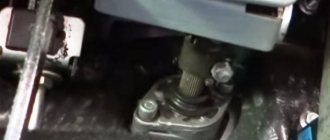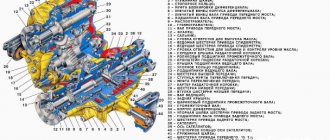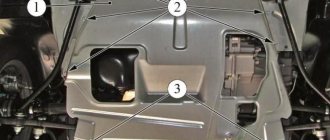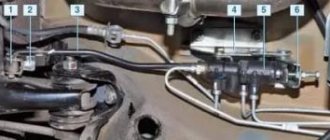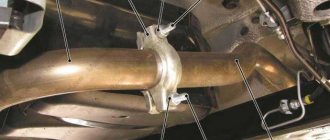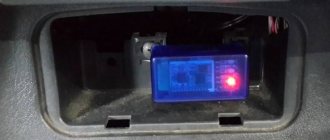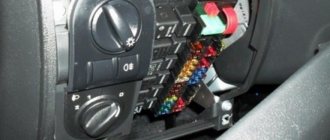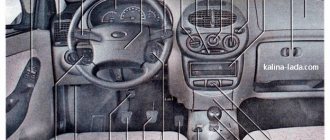November 28, 2014 Lada.Online 369 293 16
The combination of devices of Lada Granta and Lada Kalina 2nd generation is designed to display driving characteristics, the current state of vehicle systems that ensure traffic safety, as well as the correct operation of the entire vehicle as a whole. Next, we will consider a description of the Lada Granta dashboard, as well as the meaning of instruments and alarms.
Description of the Lada Granta/Kalina 2 panel:
- tachometer , shows the speed of the engine crankshaft, the red scale zone indicates a dangerous operating mode for the engine;
- engine management system malfunction indicator (Check Engine) , turns on orange when the ignition is turned on and goes out after the engine starts, the lamp is lit after starting the engine or while driving indicates the failure of any element of the engine management system (does not mean that the engine should be stopped immediately, however, the cause should be eliminated as soon as possible), the error can be determined using the diagnostic connector;
- left turn signal indicator;
- emergency low oil pressure indicator , turns on in red when the ignition is turned on and goes out after starting the engine, the lamp is lit when the engine is running and a constant (for 5 s) buzzer signal indicates insufficient oil pressure in the system;
- ABS anti-lock braking system status indicator (optional) turns on orange when the ignition is turned on and after 2 seconds. after the engine starts, it goes out; in other cases, the lamp is lit, indicating a system malfunction that should be repaired at a specialized service station;
- immobilizer mode indicator lights up orange and displays the status of the immobilizer and the vehicle security mode;
- The coolant overheat indicator turns on in red when the ignition is turned on and after 5 seconds. after starting the engine it goes out, the sound signal indicates engine overheating (t>115C), the signal will be repeated until the temperature drops below 110C, when the indicator turns on, it is prohibited to operate the car, otherwise it will lead to serious engine damage;
- brake system emergency indicator , turns on red when the ignition is turned on and goes out after the engine is started, the lamp is lit and the buzzer signal (5 lights on) when the engine is running indicates a drop in the brake fluid level below the “MIN” mark in the master cylinder reservoir, operate the car with the light on indicator is prohibited;
- indicator for turning on the right turn signal (with a green filter in the form of an arrow);
- battery charging indicator , turns on in red when the ignition is turned on and goes out after the engine starts, the lamp is lit or glows half-lit while the engine is running indicates a lack of charging current due to a malfunction of the generator or voltage regulator, as well as low voltage (or breakage) of the belt generator drive, operating the vehicle with the indicator on is prohibited;
- speedometer , shows how fast the car is currently moving;
- indicator of the operating mode of the exchange rate stability system (ESC) (in a variant version), turns on yellow when the ignition is turned on and goes out after starting the engine, the lighting of the “ESC OFF” lamp indicates that the system is turned off, and lighting and flashing while driving indicates the activation of the exchange rate control system stability, in other cases the burning of the lamp indicates a system malfunction;
- signaling device prohibiting transition to higher gear “O/D OFF” (not used);
- headlight high beam indicator , indicates that the headlights are on high beam;
- signaling device for turning on the rear fog lights , indicates that the ZPTF is turned on;
- low beam headlight indicator , indicates that the headlights are low beam;
- indicator for turning on the front fog lights , indicates that the PTF is turned on;
- daily mileage counter reset button , by pressing the button, set the daily mileage counter in the liquid crystal display to 0 or select the daily or total mileage display modes;
- liquid crystal display of the on-board computer , displays information from the BC, see description below;
- door open indicator , lights up red if the door is open;
- reserve fuel indicator indicates the need to refuel the vehicle; do not allow the gasoline to run out completely, as this may damage the fuel pump;
- low tire pressure indicator , lights up when tire pressure drops;
- the electric power steering status indicator (connected in a variant), turns on in orange when the ignition is turned on and goes out after the engine is started; the lamp is lit while the engine is running indicates a malfunction of the power steering, which must be eliminated as soon as possible;
- driver's seat belt warning light , lights up when the ignition is turned on if the seat belt is not fastened;
- power unit fault indicator (not used);
- Airbag status indicator turns on in orange when the ignition is turned on and goes out after the engine starts; in other cases, the lamp is lit indicating a system malfunction; you must contact service as soon as possible, because In addition to failure in an emergency, the airbag may unexpectedly inflate.
Polyurethane silent blocks
In general, the resource of the silent block is approximately 100 thousand kilometers.
But the service life of the part is largely influenced by the operating conditions of the car. Since our roads leave much to be desired, the service life of these elements is noticeably reduced. The average mileage that the joint can withstand on bad roads is 50-60 thousand km, after which it must be replaced. What you need, what tools and materials to replace silent blocks:
- New set of silent blocks.
- Any lubricant (in the form of cream or spray).
- A hammer with a chisel or a special puller. By the way, we looked at how to make a silent block remover with your own hands. If anyone is interested, watch and do it.
- Sandpaper.
- Vise.
- Sponge.
- Water.
- Set of keys: socket and open-end.
- Jack.
- Lift, pit or overpass.
- Protective glasses.
- Gloves.
Assembly Features
Controls of the VAZ 2109. low and high instrument panel
Features of the Grants assembly are that, almost for the first time in the modern history of the brand, a fully automated and robotic assembly line was used, on which little depends on humans. The line was fully equipped with modern welding robots. Since checking the geometry of the finished body was completely entrusted to automatic control systems, the quality of the final product increased significantly. Since then, the gaps on Lada Granta bodies have been smooth, without distortions.
A distinctive feature is also the high-quality anti-corrosion treatment. It is especially good on the Sport version, which, according to the manufacturer, is distinguished by its particularly durable body.
In addition, this Lada model uses a large number of high-quality imported components. Due to this, the management of the enterprise was able to significantly increase the reliability of finished machines. Unfortunately, this approach did not take long to affect the cost. Thus, the Standard package today costs almost 400 thousand rubles, and the cost traditionally continues to rise.
However, the quality of cars is also growing, and AvtoVAZ (something incredible!) has already recalled batches of cars several times to eliminate identified defects.
LADA > Granta
How does the electronic unit on Grant work?
Before making changes to the car's firmware or performing diagnostics, you need to consider the basic principles. As much as some would like to jump right into making practical changes, you need to understand how the electronic “brain” works.
Any computing system, be it an ECU or a home PC, is a storage device. A home PC contains photos, videos, games, and work software. The computer constantly stores the user’s actions, errors, and data about software failures. All this is hidden among system files hidden from view.
The Lada Granta electronic control unit is also a computer, only the tasks it is designed to solve are more specific. There is also diagnostic information here. It is stored in RAM. This memory stores all the data that comes from various sensors. Information is stored until the block calculates everything it needs for some actions, then the information is erased from memory.
When it comes to diagnostic information, the car owner must be very careful. RAM cannot operate without a power source.
The control unit is a mini computer with specialized functionality
However, in addition to the RAM, there are other memory blocks of the controller. They are completely independent of nutrition. The data stored in them is unchanged. Unchangeable until new firmware is updated. These are PROM and ERPZU.
The first chip stores all the firmware data that was made at the factory. All the original algorithms and operation schemes of all nodes are embedded here. All diagnostic information, calibration data, vehicle weight, engine power and other Grant parameters are also stored here.
The second chip stores anti-theft information. Here are the codes that are on the alarm keys. If the codes do not match, then Grant will not go.
DIY Lada Granta repair - Lada Master
Advantages of the car
Lada granta
The lucky ones who own such a car consider its main advantages to be comfort and spaciousness of the interior, high-quality assembly, and attractive design:
I would like to note that the basic equipment of the car is distinguished by its abundance, despite the fact that the prices of the car were determined taking into account the financial capabilities of the middle strata of the population:
The car is rightfully considered a reliable vehicle, but sometimes breakdowns occur that are typical for this model range. For this reason, having decided to purchase such a car, it is recommended to clarify how possible it is to repair a Lada Granta yourself.
Body work
The appearance of a car is an important thing that any vehicle owner cares about. But no one is immune from scratches, and you should know how to deal with them correctly so that rust does not form.
Minor damage that does not reach the primer layer can be removed by polishing. To do this, you should use special pastes, which will remove a thin layer of paint in the problem area and even out the scratch to a general shade.
Some people use a wax pencil, but after it the surface should be treated with a polish that enriches the color. Shallow but wide scratches, unfortunately, will have to be painted.
Another simple job is to soundproof the car doors and hood to create additional comfort and acceptable acoustics. This way you will protect the interior from extraneous noise and squeaks, and the sound of music will become more pleasant
In this matter, it is important to choose the right material and follow the sequence of work:
Where is which pedal in the car?
Currently, vehicles with manual transmissions dominate on domestic roads. This design requires the presence of a clutch pedal in the car, in addition to the two main ones - brake and gas. It’s worth taking a closer look at their functionality.
Clutch pedal
The leftmost lever controls the clutch. The location of the pedals on the mechanics in any car of any brand will be the same. During the start, the driver must depress the clutch in order to be able to change gears sequentially.
It is important to know that the smooth start on cars with manual transmission depends on the smooth release of the leftmost pedal and the parallel light pressing of the rightmost pedal, which is responsible for the gas.
In this position the following processes occur:
- when the left foot sinks the lever into the floor, then at the same time the clutch discs are disconnected, which entails the cessation of the power transmission of rotation from the engine to the wheels through the transmission;
- without raising his foot, the driver with his right hand on the “mechanics” moves the gear knob from the neutral position to the “first speed” position, which allows the gears on the shafts (driver and driven) to reconnect into the required pairs, providing the specified gear ratio;
- Now you can slowly release the clutch, moving your foot to the upper position, which will allow the discs to move closer to each other and finally return to the working closed position, ensuring the transmission of rotation from the motor.
Rear suspension
Timing belt lada granta
Unlike the front, it has undergone virtually no changes. Here, just like on the first Soviet G8s, a semi-independent beam is used. It is attached to the body on hinges (fortunately, there are no “crabs” in the design). A helical spring with constant stiffness is used as an elastic element. To dampen vibrations and prevent swinging, two shock absorbers are used.
- High reliability. The design does not have additional levers, which, in addition, can bend when falling into a large hole.
- Energy intensity. The Lada Granta absorbs all bumps perfectly, especially if oil shock absorbers are installed at the rear.
- Cheap maintenance. Due to its simple design, this pendant can be rebuilt even with your own hands. And the cost of new rubber-metal elements is unlikely to empty the pockets of even the most stingy car owner.
The main difference between the “Grant” suspension is the wheel alignment angles.
On-board computer firmware Grants
You can update the software yourself. To do this, you will need a USB-K-Line cable, the firmware itself, a diagram of the Lada Granta ECU, an installation program and a driver for connecting to the adapter.
BC connection diagram for firmware
Schema collection algorithm:
- Take 3 wires.
- Switch T1 is closed as required by the program.
- The computer serves as the power source; just connect to Molex. For the on-board device, you can use the terminal block from the cooler.
- Connect the adapter to the USB port and install the driver. Next, you need to remember the port number you are using.
The firmware process looks like this:
- The program starts and the firmware is selected.
- The desired port is selected.
- Click on the lightning icon, after the “Turn on power” message appears, you need to press any button and start the firmware protocol, this will take several minutes.
To download all the software necessary for flashing the firmware, just go to the official website of the manufacturer of the Lada Granta on-board computer. You can also find all the necessary drivers there.
Application
If you resort to the method of reading the LADA Granta manual from the end, then it is in the appendices that you can find the most necessary information characterizing the car from different angles. Here you can find the volume of the fuel tank, the type of gasoline recommended for use, and the quantitative expression of the volume of various liquids (lubrication, cooling, etc.) belonging to specific components.
The pictures will allow you to recognize the type of “consumables” used and their technical aspects (for example, lamps and their power, etc.).
Here there is a huge tabular material on the tightening torques of fasteners. Recommended tools for use are provided.
Features of design solutions in the front suspension
The front suspension in the LADA Granta is based on the following aspects:
- independent design with hydraulic shock absorbers;
- a pair of wishbones;
- anti-roll bar;
- the levers are equipped with auxiliary braces;
- the spring, combined with the shock absorber into a single strut, has a conical profile and coils of variable cross-section.
The shock absorber strut is connected to the steering knuckle by a lower bracket. The design feature is that during a turn with a fist, the shock absorber and spring rotate. The scheme is very simple. This solution made it possible to preserve the technological hole in the shock absorber body, which helps to increase its service life.
The pillar supports have undergone some modifications, which made it possible to get rid of unpleasant squeaks and increase the strength characteristics of the structure.
The transverse stabilizer is based on spring steel. Its middle part is fixed to the body, both end sections are fixed to the mounting points of the transverse arms.
The modernized front suspension of the domestic Lada Granta differs from its counterpart in other representatives of the model range due to the increased steering angle of the wheels. The value of the so-called cluster reached 2° 45`. The undeniable advantage of this solution is the improvement of directional stability, especially when driving at high speeds. The other side of the coin is the slightly increased required force that should be applied to the steering wheel during a turn. If you believe the reviews of the owners, this moment is almost imperceptible.
This is due to the modernization of the steering control unit, namely:
- integration into the unit of an amplifier with an increased compensating effect;
- use of a short-throw steering rack.
This approach resulted in improved handling and resulted in a reduction in the number of steering wheel rotations. And the steering wheel itself now has more information and sensitivity.
Based on reviews from LADA Granta owners, one can judge that the designers have adopted a design solution that is strange for the modern era of automotive manufacturing - this is when a standard suspension is used and there is no power steering in the steering mechanism. Can this solution be interpreted as a way to reduce the cost of the design?
Refinement of the Granta liftback dashboard
The basic equipment of the dashboard of the Lada Grant “Norma”, “Standard” is quite simple and uninformative. The defect was promptly corrected by manufacturing a new panel sample. It is installed exclusively on the “Lux” modification. An alternative option outside the factory version is provided. In order to increase the information content, a new instrument layout and external design are used:
- the borders of the instruments are separated by a chrome insert;
- more space is allocated for a computer monitor;
- the owner can independently choose the color design of the backlight in order to reduce eye strain;
- basic (important) information is now displayed at the top of the display.
Probable causes of suspension malfunction
View of the front suspension “from under the wheel”
The unpleasant creaking of the front suspension of the Lada Grant, “breakdowns” in its operation lie in the malfunction of the elements of this component of the car. Conventionally, they can be divided into two groups: the shock absorber strut with its contents and all the rest. The reason for separating the strut into a separate category is due to the increased load on it: it simultaneously performs the function of an upper arm and dampens vertical vibrations of the wheel.
The main causes of malfunctions of the telescopic stand include the following:
- Loosening of the attachment of its upper support to the supporting body.
- Destruction of the rubber buffer.
- Liquid leakage from the shock absorber, scuffing on its rod, damage to the chrome coating of the rod.
The shock absorber is leaking (needs replacement)
In the photo: lower lever assembly with ball
Damage to the ball joint is also possible, usually caused by an overestimated service life or the installation of a substandard part. Worn rubber bushings in the stabilizer and braces will also affect the smoothness of the suspension. Breakage of the main spring is unlikely, but natural wear or installation of a non-standard model can cause a loss of elasticity of the suspension as a whole.
Self-diagnosis of faults in the front suspension
There are several explanations for even one symptom of a breakdown, so it is better to identify the true cause of the malfunction at a bus station.
The following groups of signs of deviations in the operation of the front suspension can be distinguished:
- Spontaneous deviation from straight-line movement, “yaw” of the machine.
- Noises, knocks, “breakdowns” when driving on uneven roads.
- Reduced service life of suspension elements, their rapid failure.
The paint on the stand has come off and the stand has begun to rust.
The first group usually includes malfunctions of the stabilizer. You can visually inspect the entire suspension and, if there are no signs of dents or deformations, then it is worth checking the setting of the toe-in/camber angles of the front wheels. Externally, their deviation is observed in the uneven wear of the tread of the front wheels, but it will take some time for the tires to wear out.
There is a chance to detect this failure by ear: when entering a turn, you will hear the creaking of rubber, and the steering wheel usually does not return to its original position on its own.
A creaking sound in the front suspension is one of the temporary malfunctions of a Lada Granta car if it is caused by operating the car on a polluted or sandy road. In this case, sand particles may get into the rubber seals (silent blocks) of the stabilizer or braces. After washing the noise disappears.
The “couldn’t be simpler” suspension is just a plus.
The suspension is “simple to the point of disgrace”, a crab, a strut, a lower ball, two silent blocks - and that’s it, that’s all its capital.
After any work that involves disconnecting the hub from the strut, it is necessary to do a wheel alignment. As a last resort, you can try using a chisel to make marks on the strut and on the camber bolt (it's on top).
Knocking noise when driving over uneven surfaces
Knocking in the suspension when driving over uneven surfaces is also uncharacteristic: the Lada Granta, although not an off-road vehicle, is quite capable of overcoming small bumps. Typically, knocking noises occur when fasteners are loosened, nuts are tightened, or the ball joint or shock absorber strut is worn out.
If the service life of the suspension elements is too short, there are usually two reasons: poor quality of the parts used or an overly dynamic, aggressive driving style.
It is also worth paying attention to the compliance of the front wheel rims and tires themselves with those recommended by the manufacturer
Reasons for flashing the ECU
Incorrect operation of the system can be eliminated by flashing it
Granta is equipped with an M74 controller 11186-1411020-12. Its functionality is significantly different from what was installed on cars previously. Firmware methods that could be used on other ECUs do not work here.
The car, configured at the factory, meets the requirements of car enthusiasts and Grant owners. However, some still flash the system. And there are several reasons for this:
- The 8-valve Granta does not hold speed when the air conditioning is on;
- there are difficulties in starting a cold engine;
- temperature conditions are incorrectly determined;
- stopping the engine;
- lack of dynamics;
- increased fuel consumption.
A Lada Granta with an automatic transmission may experience various kinds of difficulties when choosing the required gear already at medium speeds. Granta constantly wants to drive at lower speeds. In city mode with small traffic flows this is not critical, but when driving on the highway and in a dense flow of cars there may be problems when maneuvering.
Some motorists complain about the impossibility of smooth transitions and weak traction if the engine operates at low speeds. There is an opinion here that the controller was initially flawed, namely, the parametric characteristics were not calculated at the factory. Only firmware will help solve this situation.
Designation of icons on the Lada Granta instrument panel
The dashboard diagram shows all the icons, sensors and indicators responsible for the operation of the car. Limited quantity - 39 pieces, does not clutter the instrument cluster. At the same time, the dashboard is very informative.
Designation on the Lada Granta instrument panel:
- Tachometer - designed to display the number of revolutions of the internal combustion engine. The area highlighted in red indicates a dangerous situation in the motor load.
- Sensor of a faulty motor control module. The lamp lights up (orange) when the ignition is turned on. After the engine starts, the indicator goes out. If it is constantly burning, it is worth checking the functionality of the elements of the entire motor control system.
- Signal lamp for left turn signal on.
- The engine oil pressure sensor is activated (red) when the ignition is turned on. When the required pressure is reached, the sensor goes out. A constantly active indicator (more than 5 s) shows problems with the pump, cylinder-piston system, and low oil level.
- ABS system indicator light - if it does not go out after 2 seconds, then there are problems with the traction control system. Lights up when the ignition is on (orange).
- Immobilizer indication lamp - standard anti-theft system. An orange light indicates the vehicle's security status.
- The coolant temperature indicator is on for no more than 5 seconds after starting the engine (red lamp). A light that does not go out indicates a high refrigerant temperature (above 115 ℃). The motor may overheat. When the temperature drops below 110 ℃, the lamp will go out and the sound alarm will stop sounding.
- The brake system emergency indicator turns off (red) after starting the engine. When the light is constantly on, it is worth checking the fluid level in the tank. The minimum mark indicates that it is necessary to add brake fluid to the container.
- The right turn signal indicator light is green arrow.
- Battery charge level indicator – turns on when the ignition is activated. The light goes out after starting the engine. If this indicator on the Lada Granta instrument panel is constantly lit, it means there is no charging current as a result of a faulty operation of the voltage regulator or generator. This option is possible if there is insufficient tension (break) of the generator belt.
- Speedometer – displays the current speed of the car.
- Stability sensor - lights up when the ignition is turned on. The indicator should go out after the engine starts running. But if it is constantly on, then the directional stability function is disabled. Flashes or lights up while driving – there is a malfunction in the system.
- Gear shift indicator – signals the impossibility of upshifting.
- The high beam light is on.
- Indicator that the rear fog lights are on.
- Low beam light.
- Indicator that the front fog lights are on.
- Daily mileage reset key – used to reset daily mileage or select modes for displaying daily or total vehicle mileage.
- Route controller display – trip data, current time, mileage, air temperature and more are displayed. The difference may depend on the vehicle configuration.
We recommend: How to remove the instrument panel (dashboard) on a VAZ 2114 In the first line - time, in the second - mileage. The third line displays the temperature outside the car or other options, the fourth line displays the fuel level.
- The car door unlocked warning light is red.
- Fuel level indicator – lights up when refueling is necessary. Ignoring the minimum fuel level may result in fuel pump failure.
- The tire pressure indicator lights up when the ignition is activated and goes out after the engine starts. Lights up continuously when the parameter drops to the minimum safe value.
- The warning lamp for a problem with the electric power steering informs about a malfunction in the unit.
- The seat belt fixation sensor does not light up when the engine is running and the seat belt is fastened.
- ICE performance indicator - lights up when the engine starts. If the sensor does not go out within a few seconds, this indicates the presence of damage in one of the motor components or elements of attachments.
- The airbag sensor turns on when there is a malfunction.
Setting up and unlocking
You can unlock the onboard vehicle using the same firmware. Setting up the device is a simple task if you follow the instructions included with the device. You can also find out the answer to your question on the manufacturer’s official website or watch training videos.
Using the instructions, you can not only quickly set up the device, but also find out the codes of all possible errors. This will help to diagnose the malfunction in time and take measures to eliminate it.
In comparison with the standard BC on the Granta dashboard, any other on-board vehicle will be distinguished by its expanded functionality. You can do without them, but in this case, if you need to diagnose the car, you will have to contact a service center. By installing an on-board computer, the owner of the Grant can independently monitor all engine operation processes, diagnose malfunctions and activate some parameters.
Additionally, those owners of Lada cars who are not satisfied with the minimal information content of its built-in instrument panel do not miss the opportunity to buy a route on-board computer on the Grant. All the subtleties when purchasing lie in what kind of car router is needed, since the supply of models on the market is small. Nevertheless, they are enough for the right choice and independent installation of the on-board computer on the Grant.
Downloading a book
After successfully completing the payment (by any method) and returning to the KrutilVertel store from the payment system website, you will be taken to the successful payment page:
The book you purchased will be in your personal account, from where you can always download it.
Please note that after making the payment, you need to return back from the payment system website to the KrutilVertel website. If for some reason you did not return back to the site and closed the payment system tab with a message about the successful completion of the payment, please let us know - we will send you a letter indicating access to download the book
If for some reason you did not return back to the site and closed the payment system tab with a message about the successful completion of the payment, please let us know - we will send you a letter indicating access to download the book.
Dealers' opinion
The only remark is that some AvtoVAZ dealers in the capital honestly state that their product does not have a galvanized body at all. This is due to the low price of the car. Therefore, you need to be especially careful when choosing a car and check the manufacturer’s promises in practice.
If there is no galvanization as such, then it will be necessary to use additional semi-liquid protective agents that are applied to the metal surfaces of the car. They significantly increase the corrosion resistance of even those vehicles that have not been subjected to additional anti-corrosion treatment.
Controls and additional devices
Vehicle controls include:
- clutch pedal;
- brake pedal;
- gas pedal.
The front panel is very difficult to remove. In addition to the listed special devices and fret controls, it also contains some additional devices that are located in its central part.
The control system of the Lada Kalina is simple, so neither professionals nor ordinary car enthusiasts have any problems with it. It includes the following devices.
- Control mechanism for interior ventilation and heating.
- Air conditioner control device.
- Rear window heating control device.
- Ashtray.
Adviсe
Antifreeze leaked into the cabin
To prevent problems with the heater core, you need to carefully monitor it. For example, from the first days of buying a car, periodically look under the car to see if there are dark spots there. And in the engine compartment it would be a good idea to observe the condition of the cooling system hoses. If you notice traces of antifreeze in any of these places, you need to immediately seek help, or carry out repairs yourself.
If possible, the hoses for connecting the heater radiator should be replaced with new ones, having coated the connection points with sealant. But some do not agree with this opinion. After all, sealant from the hose can get inside the cooling system and cause damage to the pump. As a result, the timing belt will break and the valves will meet the pistons.
Basic data for monitoring, adjusting and maintaining the cooling system
| Temperature at which the main thermostat valve begins to open, °C | 85-89 |
| Full opening temperature of the main thermostat valve, °C | 102 |
| Opening pressure of the outlet valve of the expansion tank plug, kPa (bar) | 110-150 (1,1-1,5) |
| Opening pressure of the inlet valve of the expansion tank plug, kPa (bar) | 3-13 (0,1) |
| Coolant temperature in a warm engine at an ambient temperature of 20–30 °C and a fully loaded vehicle moving at a constant speed of 80 km/h, no more, °C | 95 |
| Volume of liquid in the engine cooling system, l | 7,84 |
| Coolant (mixing liquids of different brands is not allowed) | Cool Stream Standard; Cool Steam Premium; Antifreeze-TS Felix, Felix Carbox-40 |
VAZ-2105 drift, 10,000,000 rub.
This car was definitely a surprise. A “Zhiguli” for 10 million is something that many people can’t even wrap their heads around. But just look at this “miracle”. The owner is definitely a fanatic.
VAZ-2105 was made specifically for drifting by a professional racer. Equipped with a special turbo engine from a foreign car with a capacity of 600 horsepower. Through the “Zhigotsar” (as the car was nicknamed) the silhouette of the usual Lada is only slightly visible.
The geometry of the front suspension has been completely changed. And the body became much larger. The owner drove the VAZ for more than 10 years in drift competitions and only three years ago decided to change the engine and make other reconstructions.
general information
Headlight settings are lost for a variety of reasons - from off-road conditions to minor traffic accidents.
Symptoms can also vary, for example, problems with low beams most often arise due to a broken relay or fuse.
Let’s also make a reservation that the headlight corrector installed on Grants can only compensate for the different load of the car, however, the car owner must level the horizontal plane independently.
The main reason for adjusting the headlights is the lack of light when illuminating the road, which has several possible reasons:
- Typically, a car that comes off the assembly line is adjusted to the weight of the average car owner (75 kg). If your body weight differs from the weight specified in the settings, then it is better to carry out the adjustment immediately after purchasing the car;
- If the hydraulic corrector breaks down, which results in bending of the headlights and difficulty making adjustments;
- After driving off-road;
- When buying a used car, since in this case the headlights were adjusted by the previous owner of the car to suit his own needs and weight.
Let's take a closer look at hydraulic correctors. These devices are installed on cars by the manufacturer and are designed to adjust the headlights higher or lower, depending on the degree of load on the car.
Since they do not have automatic adjustment, the adjustment must be carried out independently; the controls for the corrector are located at the light switch.
The zero position corresponds to a car with one person in the cabin (driver).
The operating principle of the device is as follows:
- the corrector cylinder is controlled using a handle;
- the cylinder is responsible for adjusting the pressure level in the tubes going to the pusher;
- the pushers are located directly in the headlights, and the higher the pressure in the tube rises, the more actively the liquid located in the inside of the pusher will press on the rod;
- The most important position for adjusting headlights is the position in which the rod is located.
If the corrector breaks down, which often results in one of the headlights stopping responding to it, the pusher needs to be repaired - it is its failure that in the vast majority of cases leads to a malfunction of the device as a whole. There are two methods for repairing a pusher. The first of them does not provide for its subsequent adjustment; to implement this technique you will need:
- Remove the broken pusher from the headlight;
- Warm up the pusher tube (this will give it greater elasticity), and then remove the pusher from it;
- Tighten the self-tapping screw from the side of the tube (be sure to screw it at an angle, the degree of protrusion of the rod directly depends on the depth of the screw);
- Then adjust the length of the screw to get the final result you need.
The second method involves returning the hydraulic corrector to a fully functional state. To do this you need:
- Remove the pusher from the headlight;
- After warming the tube, remove it from the pusher;
- Try to move the pusher using pliers (the device will not function if there is not enough liquid in it or there is no proper pressure);
- When the rod moves, antifreeze is pumped into the pusher (using a conventional syringe), after which the system is put back together;
- If there is no movement of the rod, you should pump a small amount of antifreeze into the pusher (to the required level), and try to develop the rod;
- The optimal level of liquid inside the pusher can be determined both experimentally and by comparing a faulty hydraulic corrector with a working device.
Functionality on board the vehicle
The manufactured models of onboard vehicles for the Lada Granta have a wide information memory and are equipped with a monitor. This significant advantage is beneficial even for drivers with poor vision and women who are not very confident in the functioning of the car. In this regard, the on-board computer can help the car owner. He points to:
- travel time;
- fuel consumption at different speeds and driving rates, up to a liter;
- average speed levels and gasoline costs per trip;
- residual quantity in the fuel tank;
- speed when starting the car;
- speed when driving until the engine is completely warmed up;
- engine heating level to avoid overheating;
- various problems with Lada mechanisms;
- timely heating and drying of candles;
- temperature in the cabin and outside.
In addition to these functions, the on-board computer on the Lada Granta has volatile memory, a malfunction indicator, a supervisor (warning about unplanned vehicle movement, unswitched headlights and direction indicators) and afterburner. The latter resets the memory when switching to the gas pedal when accelerating the Lada to its original settings when using gasoline no lower than 95.
The standard on-board computer of the Lada Grant, namely the State X1 M (Multi-Set) model, is considered the highest priority on-board computer for the Lada family. Compact dimensions allow it to be built into the instrument panel in the recess of the button cover. If a car owner wants to buy a State on-board computer, then, in addition to the device, the kit will include instructions and wiring.
The filling of the State X1 M model consists of a built-in trip computer, in which all the necessary information on the operation and diagnosis of Lada mechanisms will be processed.
A diagnostic tester can provide a lot of information about the car's condition.
The on-board computer diagnostic tester is equipped with a plasma, digital tachometer and speedometer. Using the tester, it is easy to clarify the position of the throttle valve and the state of the electrical network on board, which will help prevent possible damage and fire to the vehicle's electrical wiring.
Shock absorber
This element is a damping device. The shock absorber serves to reduce the range of vibrations of the car body. In other words, the element prevents spontaneous rocking. The work of the shock absorber is based on hydraulic resistance. Inside it there is a liquid of a certain viscosity. It moves through a special valve. Thus, the device absorbs sharp impacts while preserving vulnerable suspension parts. Therefore, the shock absorber is one of the most important components in the chassis. On our roads, this element lasts about 60-80 thousand kilometers. But this period may be shorter, even with careful driving. It is enough just to damage the protective boot, and all the dirt will accumulate in the rod seal.
rear shock absorbers, hydraulic fluid
Also note that the damping element changes in pairs. That is, in the event of a breakdown of the rear left shock absorber, the rear right shock absorber also changes. As for the front struts, they are more durable. Often they are replaced already assembled with a spring, since they fail no earlier than after 150-200 thousand kilometers.
Repair of VAZ (Lada) Granta
The pages of this section of etlib.ru represent a complete repair manual for the Lada Granta. The abundance of information materials present on the portal will allow you to find an algorithm for repairing any part and understand it even without experience or special training
Videos and photo reports will demonstrate each stage of the repair work, focusing on key points. Their knowledge will save the car owner from a fatal mistake, which will entail serious consequences.
Anyone interested in repairing and servicing the Lada Grant will be interested in those instructions that are viewed by drivers more often than others. “Popular” procedures include: replacing the timing belt, replacing a light bulb and changing the oil in the box. In the event of a breakdown in the car's electrical system, manuals on how to replace an alternator or replace an alternator belt on a Grant will be useful materials.
Any questions that arise during the process of studying the repair algorithm can be asked directly on the website. To do this, just formulate the question correctly and then post it on the appropriate page. The number of experienced owners and specialists visiting the portal is so large that within the next few hours after its appearance, someone will already give a comprehensive answer.
“Itelma 11186-1411020-222”: from stock firmware to chip tuning?
The dilemma associated with the rationality of performing firmware on the “native” software in the ECU excites the minds of many owners.
Here it is worth highlighting the optimized dynamic firmware version for the 1.6-liter 8-valve Lada Granta, which has the “M74” module and meets the toxicity standard according to “E2”.
What preferences does this firmware have? After performing a certain list of manipulations and returning the ECU to its rightful place, optimization of the parameters of fuel supply and ignition distribution is observed. Also, one of the purposes of the firmware is to ensure that the settings of the throttle assembly are adjusted.
Chip tuning allows you to physically disable the 2nd DC (“lambda”) in combination with the catalyst. The implementation of such firmware leads to an increase in the dynamic capabilities of LADA Granta.
The role of the stock firmware is to form the parameters characteristic of normal driving conditions. Let us remind you that the “native” version of the firmware is included in the warranty package. Self-correction of the firmware version without any alternative leads to the cancellation of warranty coverage.
Timing belt Lada Granta 8 valves
Today, so-called commercial versions of firmware software are available to the mass consumer, including the following:
- “AY_I484GG30”, the product is intended for the 1.6-liter 8-valve Granta modification with the present control module “M74 11186-1411020-22”;
- “I484GI06-STR”, software is offered for Grant with similar motors and blocks in version “11186-1411020-22”, plus compliance with the Euro-2 standard;
- “AY_484GP12”, the firmware is used with controller versions “M74 11186-1411020-22” and motors that comply with “E3/E2” regulations.
General information
This paragraph outlines the general characteristics of the technical component of the Lada Granta. Information concerns:
- weights in various categories (full, loaded, etc.);
- engine volume and its power indicator paired with torque characteristics;
- speed and dynamic capabilities of the Lada Granta car, etc.
The operating instructions also contain data regarding the configuration options of the proposed vehicle, and their distinctive aspects are noted. The photographs show the location areas of specialized plates containing factory nameplate information.
What types of ECUs are available to Granta and what is the principle of their operation?
Sometimes the Lada Granta model is identified with an exclusive car. Why is she given such status? It's simple. "Lada" has a unique control unit, which is called "Itelma 11186-1411020-22" and cannot be combined with previous modifications of "VAZ". The primary difference of this module is the integrated “CAN bus”. Previously produced models used the “K-channel” to ensure the transmission of pulses. If you set out to experiment and replace the Itelma with a similar device with functionality in the K-channel, then in the end the devices on the panel will certainly “fall asleep”.
Where is the ECU located and what is its operating principle? It is based on a special type of algorithm, the formation of which occurs on the basis of software pre-integrated into memory. This allows the module to process signals from all sensors present in the ECM in real time.
The process associated with processing streaming information allows the control unit to subsequently carry out corrective actions regarding the functioning of such systems:
- nozzles;
- ignition system coils;
- throttle mechanism;
- sensor-regulator of idle modes, etc.
To be able to identify the type of device in a LADA Granta car and the firmware version of its software, a special marking code is applied to the body, which allows for the correct selection of an analogue if there is a need for replacement, and in some cases pinout of the ECU is required.
Technical characteristics of Lada Granta 2022 model series
At the moment, the development of the vehicle is being actively carried out. The main work is focused on the creation of a new turbocharged power component. Judging by the latest information, this particular engine should be used on some of the trim levels of the new product in 2022. According to official information, the VAZ-11192's entry into mass production is scheduled for the first half of 2022. At this time, under its hood there will be a turbocharged power component with 4 cylinders and 16 valves, which meets the current environmentally friendly requirements of Euro 5. The engine dynamics are approximately as follows: 150 horsepower and 240 Nm of torque. The basis for the new product was a 1.4-liter turbocharged naturally-aspirated engine, the maximum power of which never exceeded 90 horses. It was this motor that was previously used on the first generation Kalina.
The new Granta configuration differs from its previous assembly by a modified connecting rod and piston group, a modified gas distribution mechanism, and a more advanced cylinder block. The new engine also has additional components:
- an exhaust manifold;
- turbocharger;
- injector ramp;
- receiving tube with neutralizer;
- intake module;
- oil and water pump.
Most likely, a gearbox from Renault-Nissan will work with the turbo engine, since AvtoVAZ does not have an appropriate transmission that can cope with such loads. But an imported part of a similar type will significantly increase the cost of the new product, so for now the issue of transmission remains unresolved.
